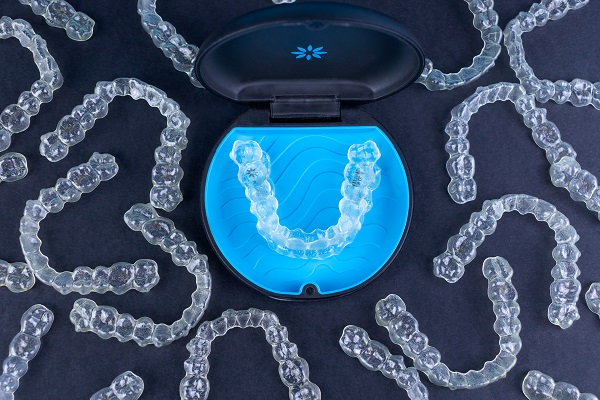What Are Invisalign Clear Aligners?

Invisalign® is a teeth-straightening treatment that entails wearing sets of custom-made transparent aligners over the teeth. Unlike traditional metal braces that use wires and brackets, the aligners are removable, which means wearers can take them off when they want to eat or brush their teeth. Learn about these clear aligners and how they are used to straighten misalignment.
Invisalign® in orthodontics
Invisalign® clear aligners are fabricated from nearly invisible polyurethane plastic. Instead of being glued to the teeth like metal or clear braces, The aligners are removable for eating, brushing and flossing, or during important social events. This advantage can also be a drawback, however — patients have to stay committed to wearing the aligners for the minimum number of hours if they want effective results. Other benefits of Invisalign aligners over traditional braces include:
- A discreet appearance
- More dietary choices
- Greater comfort
- Teeth-grinding protection
- Improved oral hygiene
Clear aligner technology has improved with time and is now effective for correcting malocclusion that would otherwise have been too complex for this treatment option. However, there are cases where traditional braces would be more effective. The dentist can discuss this in detail with the patient.
How Invisalign® works
The clear aligners use the same principle as traditional braces, putting controlled pressure on the teeth to shift them to a better position. Specialized computer software helps to guide the teeth’s movement from their current position to the correct place. The software breaks down the movement into several steps. For every step, the provider will produce two plastic trays or aligners to fit over the top and bottom row teeth.
The patient will wear the first set of aligners for two weeks, for at least 20-22 hours daily. After that, they will replace the pair with the next pair of aligners in the series to achieve the next movement progress. This process will continue until the teeth are in correct alignment.
In the past few years, Invisalign® has incorporated two features to make this a suitable orthodontic treatment option for teenagers. There is a unique “eruption tab” to preserve the space for undeveloped molars. Invisalign® for teens also has a compliance indicator that fades with wear. This helps ensure that the patient is wearing the trays according to the instructions, since treatment success depends on it.
Dental care with Invisalign®
One of the primary advantages of using Invisalign® is that the aligners are removable for maintenance and dental care. Patients need to brush their teeth after eating to prevent food debris and plaque from getting trapped in the aligners, which may contribute to tooth decay and gum disease. The aligners must also be cleaned regularly by brushing them and rinsing in lukewarm water.
In conclusion
Although Invisalign® clear aligners are different from braces, they offer the same basic outcome of straighter teeth. To learn more about clear aligners and how you can benefit from the process, contact the general dentist for an appointment.
Request an appointment here: https://www.carpinteriasmiles.com or call Carpinteria Smiles at (805) 920-2141 for an appointment in our Carpinteria office.
Check out what others are saying about our dental services on Yelp: Invisalign in Carpinteria, CA.
Related Posts
While dentists strive to save natural teeth whenever possible, certain situations may require tooth extractions to preserve oral health. When severe damage, decay, infection, or other oral health issues threaten the health of your smile, an extraction can save it. It is important patients recognize the signs of trouble and seek treatment promptly.Extensive tooth decay…
If you have an extensively decayed tooth or the filling applied is too big for your tooth to support it, your dentist will probably recommend putting in a dental crown. This is a prosthesis designed to look like a natural tooth, but it is hollow inside to fit over the damaged tooth. In addition to…
Invisalign® is a dental treatment that involves using clear plastic aligners to correct misaligned teeth without the need for uncomfortable metal braces. How long should patients wear? There are several factors to consider when choosing how long you'll wear your aligners, including your age, the severity of your misalignment, and how flexible you are with…
Is it time for a smile makeover? If you look in the mirror and do not like your teeth, there are things you can do to change it. Your general dentist can offer various treatments and procedures to revive your smile and give you the appearance you have always wanted. Your dentist can discuss your…
